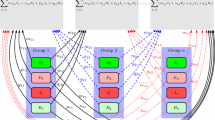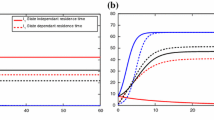Abstract
We consider a two-patch epidemiological system where individuals can move from one patch to another, and local interactions between the individuals within a patch are governed by the classical SIRS model. When the time-scale associated with migration is much smaller than the time-scale associated with infection, aggregation methods can be used to simplify the initial complete model formulated as a system of ordinary differential equations. Analysis of the aggregated model then shows that the two-patch basic reproduction rate is smaller than the 1 patch one. We extend this result to a linear chain of P patches (P > 2). These results are illustrated by some examples for which numerical integration of the system of ordinary differential equations is performed. Simulations of an individual based model implemented with a multi-agent system are also carried out.






Similar content being viewed by others
References
Bousquet F, Bakam I, Proton H, Le Page C (1998) Cormas: common-pool resources and multi-agent systems, in IEA/AIE ’98: Proceedings of the 11th international conference on industrial and engineering applications of artificial intelligence and expert systems: tasks and methods in applied artificial intelligence, vol 1416, Lecture Notes in Computer Science, Springer, pp 826—837
Gregorya R, Saundersb JR, Saundersc VA (2006) The Paton individual-based model legacy. BioSystems 85:46–54
Hamer WH (1906) Epidemic disease in England. Lancet 1:733–739
Hassell MP (2000a) Host–parasitoid population dynamics. J Anim Ecol 69:543–566
Hassell MP (2000b) The spatial and temporal dynamics of host–parasitoid interactions. Oxford University Press
Hassell MP, Wilson HB (1997) The dynamics of spatially distributed host–parasitoid systems. In: Tilman D, Kareiva P (eds) Spatial ecology. The role of space in population dynamics and interspecific interactions. Princeton University Press, pp 75–110
Hassell MP, Comins HN, May RM (1991a) Spatial structure and chaos in insect population dynamics. Nature 353:255–258
Hassell MP, May RM, Pacala SW, Chesson PL (1991b) The persistence of host–parasitoid associations in patchy environments. A general criterion. Am Nat 138:568–583
Kermack WO, McKendrick AG (1927) Contributions to the mathematical theory of epidemics, Part I. Proc R Soc Lond A 115:700–721
Lett C, Auger P, Bravo de la Parra R (2003) Migration frequency and the persistence of host–parasitoid interactions. J Theor Biol 221:639–654
Nguyen-Huu T, Lett C, Poggiale JC, Auger P (2006) Effect of movement frequency on global host–parasitoid spatial dynamics with unstable local dynamics. Ecol Model 197:290–295
Ross R (1911) The prevention of malaria, 2nd edn. John Murray, London
Acknowledgements
We thank Gauthier Sallet for helpful remarks. Support from Institut de Recherche pour le Développement and Ecole Normale Supérieure de Lyon, laboratoire LIP and Institut des Systèmes Complexes is gratefully acknowledged.
Author information
Authors and Affiliations
Corresponding author
Rights and permissions
About this article
Cite this article
Kouokam, E., Auger, P., Hbid, H. et al. Effect of the Number of Patches in a Multi-patch SIRS Model with Fast Migration on the Basic Reproduction Rate. Acta Biotheor 56, 75–86 (2008). https://doi.org/10.1007/s10441-008-9036-y
Received:
Accepted:
Published:
Issue Date:
DOI: https://doi.org/10.1007/s10441-008-9036-y




